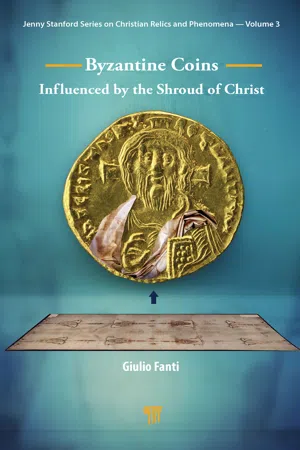
- 354 pages
- English
- ePUB (mobile friendly)
- Available on iOS & Android
Byzantine Coins Influenced by the Shroud of Christ
About this book
Numerous studies have been carried out on Byzantine coins, but there are still no univocal interpretations on the details of the figures represented there and in particular on those relating to Jesus Christ. The information derived from the studies on the Holy Shroud, the most important Relic of Christ in Christianity, has clearly resulted in some new interpretations.
This is the first book in the world that deals extensively with the effigy of Christ, despite being the most sought after and collected by numismatists. Furthermore, the book relates the different images of the Redeemer on Byzantine coins with the image of Jesus Christ on the Shroud, the most important Relic of Christianity. The numerous collectors will therefore be interested in having not only a numismatic analysis of these coins but also a historical-religious study. This book, which should be understandable to everyone, demonstrates the strong influence that the Shroud had in the Byzantine era.
Frequently asked questions
- Essential is ideal for learners and professionals who enjoy exploring a wide range of subjects. Access the Essential Library with 800,000+ trusted titles and best-sellers across business, personal growth, and the humanities. Includes unlimited reading time and Standard Read Aloud voice.
- Complete: Perfect for advanced learners and researchers needing full, unrestricted access. Unlock 1.4M+ books across hundreds of subjects, including academic and specialized titles. The Complete Plan also includes advanced features like Premium Read Aloud and Research Assistant.
Please note we cannot support devices running on iOS 13 and Android 7 or earlier. Learn more about using the app.
Information
Chapter 1
Byzantine Coinage
1.1 Byzantine Coinage Overview
| Period | Denomination | Metal | Weight [g] | Purity | Exchange ratio |
|---|---|---|---|---|---|
| I | Solidus-Nomisma | Gold | 4.55 | ≈100% | 1 |
| Approx. | Semissis | Gold | 2.27 | ≈100% | 2 |
| 550 | Tremissis | Gold | 1.52 | ≈100% | 3 |
| Hexagram | Silver | 6.7 | 12 | ||
| Follis | Copper | 288 | |||
| Half-Follis | Copper | 576 | |||
| Decanummium | Copper | 1152 | |||
| Pentanummium | Copper | 2304 | |||
| Nummus | Copper | 11520 | |||
| II Approx. 550–1092 | Solidus or Hista-menon Nomisma | Gold or Electrum | 4.55 | 11% (Electrum) up to ≈100% | 1 |
| Semissis | Gold | 2.27 | ≈100% | 2 | |
| Tremissis | Gold | 1.52 | 100% | 3 | |
| Tetarteron | Gold | ≈4 | 90% | 1 | |
| Hexagram | Silver | 6–6.7 | 12 | ||
| Miliaresion | Silver | 2.3–3.0 | 12 | ||
| 2/3 or 1/3 of Miliaresion | Silver | 18 or 36 | |||
| Follis | Copper | 288 | |||
| Fraction of Follis | Copper |
| Period | Denomination | Metal | Weight [g] | Purity | Exchange ratio |
|---|---|---|---|---|---|
| III 1092–1204 | Hyperpyron-Nomisma | Gold | 4.55 | 98–60% | 1 |
| Nomisma Trachy | Electrum | 4.55 | 10–30% gold | 3–12 | |
| Aspron Trachy | Billon* | 4.55 | copper–silver | 48–384 | |
| Tetarteron | Copper | 4 | ≈864 | ||
| Half-Tetarteron | Copper | 2 | ≈1728 | ||
| IV 1204–1367 | Hyperpyron-Nomisma | Gold | ≈4.5 | 50–60% | 1 |
| Basilikon | Silver | ≈2 | 12 | ||
| Tournesion | Billon | 96 | |||
| Aspron Trachy | Billon | 0.75 | 384 | ||
| Assarion | Copper | 3–4 | 768 | ||
| V | Hyperpyron | Gold | ≈4 | 1 | |
| 1367–1453 | Stavraton | Silver | 7–9 | 2 | |
| Half-Stavraton | Silver | 3–5 | 4 | ||
| Ducat | Silver | 1.1 | 16 | ||
| Tournesion | Copper | ≈2.4 | 192 | ||
| Follaro | Copper | ≈0.8 | ≈576 | ||
*The billon is an alloy used for coinage, containing silver (or gold) with a predomi... | |||||
Table of contents
- Cover
- Title Page
- Copyright Page
- Dedication
- Table of Contents
- Foreword
- Background to This Study
- Acknowledgements
- Initial Note
- Introduction
- 1. Byzantine Coinage
- 2. The Shroud of Christ
- 3. Images of Christ in the Byzantine Age
- 4. Details of Christ’s Face on Coins
- 5. Christ in the World’s Medieval Coins
- 6. Probabilistic Analysis Applied to a Coin
- 7. Quantitative Analysis and Third-Class Relics
- 8. The Face of Christ on Coins: Aesthetic Opinion and Experiments
- 9. Latest Findings
- Conclusion
- References
- Appendices
- Name Index
- Subject Index